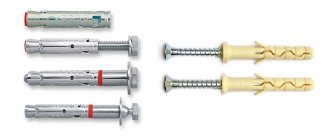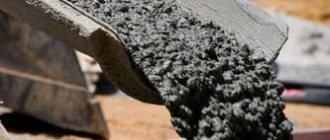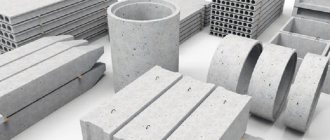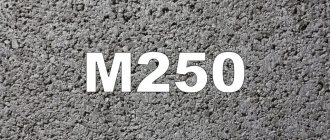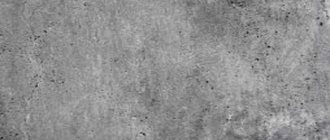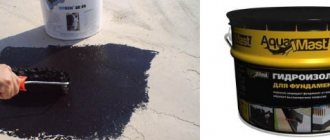Lime concrete is an ancient type of material that was used by the ancient Romans. The binder in it is slaked lime, and the filler is sand (sometimes crushed stone). Nowadays, solutions with this composition are used mainly for plastering and finishing. In ancient times, monumental structures were built on their basis.
In this article we will tell you where lime concrete can be used. You will find out what specific jobs it is used for. We will also give short information about the features of the mixture, its manufacture, main advantages and disadvantages.
Let's look at the types of crushed stone
- Crushed stone on granite is considered the best filler for concrete due to its high strength. Used for critical buildings that must experience maximum load (for example, roads and airfields, bridge structures, industrial facilities, columns, walls and flights of stairs). Performance characteristics: strength grade from 1200 to 1400, frost resistance up to F400, small percentage of flakiness (the ratio of plate-shaped and needle-shaped stones to the total mass of crushed stone).
- On gravel: made by sifting quarry rocks or by crushing rocks. It is inferior in its characteristics to crushed stone on granite, but it is also cheaper in price. They are used in road construction, for the construction of foundations (monolith or strip), for the production of floor slabs and reinforced concrete products. Indicators: strength M 800-M 1000, frost resistance up to 150 cycles, low radioactivity.
- Limestone (dolomite) is an inexpensive type of filler. Low strength, but sufficient frost resistance characteristics, influenced its widespread use in road construction.
- Crushed stone from slag is obtained through the process of splitting and dividing waste into fractions in metallurgy. It is rarely used: mainly for the construction of small utility buildings, sidewalks and parking spaces, for the creation of mineral wool and the production of Portland slag cement.
- Secondary: obtained by crushing concrete waste and bricks. The main advantage of this option is the low price. This filler is suitable for household work and repairs, but it should absolutely not be used for critical construction.
Silicate concrete based on hydrated lime
Lime is widely used in construction and the production of autoclaved dense and cellular concrete. In factory practice, the most widespread are the “boiling” schemes for the production of concrete, based on the positive effect of hydration setting and hardening of quicklime. However, its unstable properties complicate the technology and deteriorate the quality of the product.
Regulating the temperature and speed of lime slaking during the formation of cellular concrete products is associated with great difficulties. The use of highly exothermic and quickly slaking lime causes a rapid increase in temperature to 90-100°C, as a result of which water evaporates and the structure of the material is destroyed.
Due to the late quenching of unburned particles, volumetric stresses arise in the formed concrete structure, cracks and other defects appear. Therefore, GOST 9179-59 imposes strict requirements on the quality of quicklime. This significantly limits the use of raw materials and reduces the role of lime as a local binder. The cost of ground lime-lime in many cases is equal to or slightly less than the cost of cement.
Therefore, the development of methods for producing lime with stable properties is of great importance. This problem can be solved in two ways: to improve the technology for the production of quicklime and products based on it, or to use hydrated lime, increasing the efficiency of its use in concrete.
The first way is associated with a radical improvement in the industrial production of quicklime. Here, much attention is paid to improving the technology for the production of concrete products using boiling lime.
The most common methods that allow, to some extent, to regulate the process of slaking lime and eliminate the influence of burnt calcium oxide particles are the use of slaking retarders and partial preliminary slaking of it during grinding.
The second way is more profitable and promising - the use of hydrated lime. There are favorable prerequisites for organizing large industrial enterprises for the production of such lime or ready-made lime-sand binder of optimal composition and grinding based on fluffed lime (by grinding wet sand and quicklime). Such a binder can be stored for a long time and transported over long distances without loss of properties. Hydrated lime contains fewer foreign impurities, has no burnt particles and has stable activity. Its use will dramatically expand the raw material base for the production of technological lime and reduce costs.
Hydrated lime is still little used in the production of autoclaved cellular concrete. This is explained by the fact that concretes settle due to insufficient mass stability, and slow setting and increase in structural strength lengthen the pre-curing time of molded products before autoclave processing and increases the need for production space.
The compositions and production technology of dense and cellular silicate concrete are significantly different. The first ones are made from a mixture of lime and unground sand, part of which (10-12%) is replaced with ground sand to increase the strength and density of concrete. The molding moisture content of the mixture (during vibration laying) usually does not exceed 10-15%; hardness respectively 300-30 sec. activity (converted to CaO) 6-10%. Under these conditions, the properties of dense concrete based on lime-lime are higher than those based on hydrated concrete, due to the increased density of the cementitious stone based on lime-lime.
With the intensity of compaction of concrete based on hydrated lime - by pressing, vibration stamping, force rolling - their strength, density and other properties approach those of concrete based on hydrated lime. However, the use of such compaction methods in most cases turns out to be impractical and uneconomical.
Unlike dense cellular concretes, they are made using ground sand. The molding moisture content of the mixture is 40-60%, the activity of the dry mass (in terms of CaO) is 15-24%. The introduction of such an amount of water into the mixture is dictated by the conditions of structure formation of the material and the need to remove a large amount of heat released during the hydration of lime. Consequently, if to obtain cellular concrete we use hydrated lime, which is unable to generate heat, and reduce the amount of water in the mixture, using progressive methods and methods of molding, then the density and strength of the cement stone can be equal to and even exceed this (indicators of cellular concrete on lime- boiling water
The use of vibration technology for the production of cellular concrete in combination with external thermal effects on the cellular mass in the pre-autoclave period allows the effective use of hydrated lime, regardless of its activity, slaking time and temperature. Experimental data confirm this. The influence of W/T and type of lime on the strength and volumetric weight of the cementing stone is given in Table. 1.
The ratio of components is 1:1:3 (cement: lime: sand) with a mixture activity of 13.5%. Samples of dense (Table 1) and cellular (Table 4) concrete were steamed in an autoclave according to the 2 + 84-2 h mode and dried to (constant weight) before testing.
The strength of the cementing stone is greatly influenced by the number and nature of new formations that arise during the hardening of silicate concrete and depend on the dispersion of calcium hydroxide interacting with quartz.
Dispersity, in turn, depends on the hydration conditions of calcium oxide. With the increase in new formations, the strength of the crystalline intergrowth increases. Therefore, having established the possibility and technical and economic feasibility of producing cellular concrete using hydrated lime, it is necessary to study its properties under different slaking conditions and their impact on the technology and quality of finished products.
The studies were carried out on pure lime and its compositions with sand and cement.
Currently, the dispersity of calcium hydroxide is assessed by its solubility, determined by the electrical conductivity method. In most cases, the dispersity of Ca(OH)2 is judged by the strength of identical samples made with quicklime and hydrated lime, as well as by water demand or the settling rate of lime milk particles. But such an assessment is very approximate and often leads to contradictory results.
Which crushed stone is better to choose for concrete?
The choice and requirements primarily depend on the type of concrete structure. For example, high demands are placed on the concrete mixture for the foundation, so M1200 granite crushed stone is chosen as a filler. For light commercial buildings, crushed gravel is chosen.
As for the frost resistance of concrete: it is not so important when making mortar for interior decoration or pouring the floor in a room. But when pouring a foundation or even a path, it is better to use a filler that is more resistant to temperature changes.
Tips for choosing the fraction and amount of crushed stone
An important indicator by which filler is selected for certain jobs is the size of the fractions. The gradation of crushed stone looks like this: 5-10 mm, 10-15 mm, 15-20 mm, 20-40 mm, 40-80 mm.
If high strength and reliability of a concrete structure is required, crushed stone of large fractions is used, and fine-grained filler is better suited for filling cavities and voids. To fill the foundation, crushed stone with a fraction of 5 to 40 mm is used. To ensure that the concrete solution is of the highest quality and the structure lasts for many years, it is recommended to use filler of several fractions when mixing.
The shape of the grains is also important: ideal consumption of binder and good compaction of the mixture are best ensured by cube-shaped crushed stone. It is desirable that the composition contains fewer flakier grains: they reduce the performance characteristics of the mixture.
Proportions of crushed stone to other components
If you don’t know how much crushed stone you need, for example, for a foundation, then there is the following proportion formula: 5 parts crushed stone, 3 sand, 1 cement and 1.5 parts water.
Is it possible to prepare cementless concrete yourself?
The answer to this question is in the affirmative; in most cases, it is not difficult to make products from cementless concrete, or to build a building or structure using them with your own hands. We will give advice on each type of material separately.
Gypsum concrete
Making stucco molding from gypsum concrete
The instructions are extremely simple, everything is done exactly the same as when working with ordinary Portland cement.
- Mix gypsum and aggregates with water.
- We pour the material into the formwork or mold.
- We are waiting for the mixture to harden.
True, in this case there is no need to care for the finished product or structure - hardening occurs quickly, within 24 hours.
Molding a gypsum concrete cornice
Advice. Gypsum quickly gains strength. If a mixture based on Portland cement can be laid for several hours after preparation, everything with this binder must be done quickly, within a few minutes.
Asphalt concrete
Bitumen - binder for homemade asphalt concrete
This material is somewhat more difficult.
- We are preparing a container in which we will heat the bitumen; you can use an old barrel.
- We load pieces of bitumen into it.
- We begin to heat it carefully.
- When the bitumen starts to melt, stir.
- We introduce fillers into the completely melted bitumen.
- Place the hot mixture.
The main thing is to carefully heat the bitumen and mix it with aggregates
Advice. Be careful: hot bitumen may ignite if exposed to an open flame.
Silica concrete
Autoclaves for silicate products - hardly anyone has them at home
This is perhaps the only cementless concrete from which it is impossible to make products from it at home. Of course, if you don’t happen to have a press and an autoclave with live steam in your garage.
Glass concrete
Liquid glass is one of the binders for cementless concrete
The instructions (like all subsequent ones) don’t even need to be broken down point by point. Add fillers to the liquid glass mixed with the catalyst and form the structure. Hardening occurs within several hours.
Alkali-slag concrete
Everything is quite simple, but it is unlikely that you will make this type of concrete yourself. The fact is that grinding slag at home makes no sense. If you still do this, then add liquid glass to it, mix it with the filler and place it in the formwork.
Polymer concrete
Do-it-yourself production of polymer concrete products
We will also not give detailed recommendations - it all depends on what kind of binder you will use.
- If it hardens without heating, we use the same method as for glass concrete.
- For those polymers that are hot molded, the technology is the same as for asphalt concrete (however, it is also a variant of polymer concrete).
We hope our article was useful to you. We tried to let you know about materials that replace ordinary gray Portland cement. It’s good if you chose one of the concretes described above for your construction. It’s great if the technology of cementless concrete has interested you practically and has been used in life. After all, construction is not only cement and brick...
